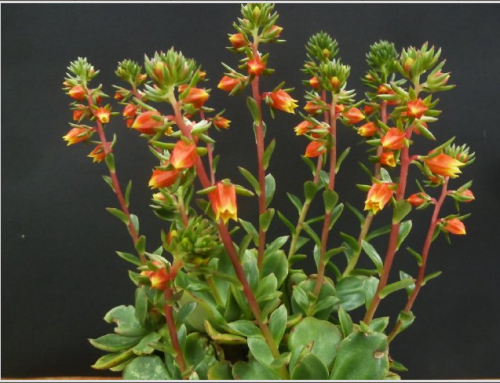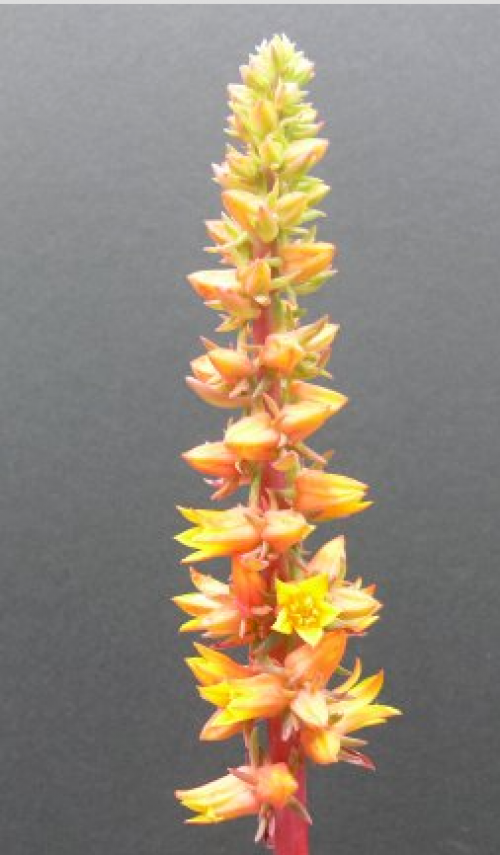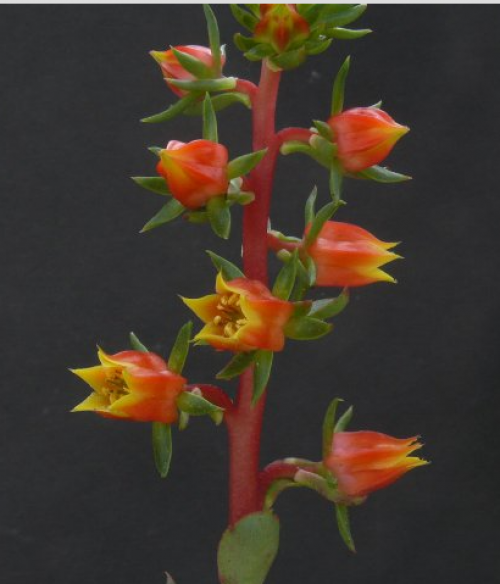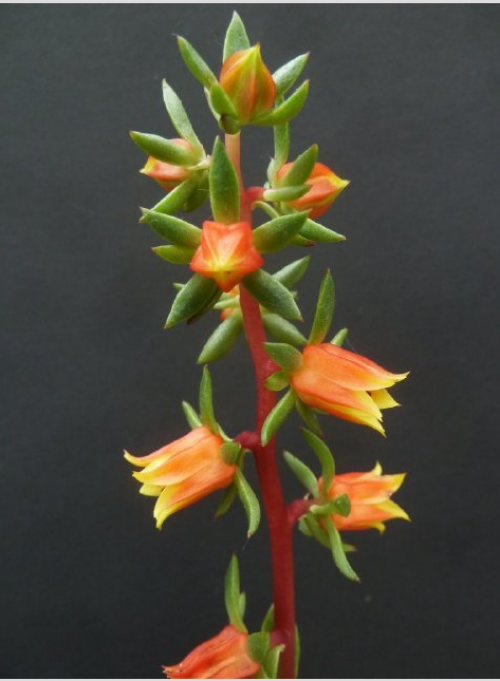MONTANA Rose, 1903
Synonym : Echeveria nuda var. montana (Rose) von Poellnitz (1936) - see Note below.
Series Nudae
Type : Pringle 4706, collected June 16, 1894, on ledges, trees etc. Sierra de San Felipe, ca 3150 m. US 48365.
Etymology : Referring to the habitat.
Distribution : Mexico, Oaxaca, Sierra de San Felipe, 2650 - 3500 m. Plants from Chiapas and Guatemala, considered to be E. montana, are wrongly identified. They do not correspond to E. montana Rose and may represent a hitherto undescribed species - see Notes below.
First Description by Rose in Bulletin of the New York Botannical Garden 3: 6. 1903 :
Caulescent.
Leaves in a dense rosette at the top of the stem, orbicular or obovate, somewhat narrowed below, glabrous, 5 - 6 cm long.
Flowering stems somewhat granular-roughened above, rather densely leafy-bracted below, 20 - 30 cm long, many-flowered, inflorescence an equilateral raceme.
Flowers : Sepals ovate-lanceolate, 6 - 7 mm long, corolla 1 cm long.
Rose' description is based on dried material, therefore the papillosity characteristic for E. montana was not visible. Nevertheless the flowering stem is described as granular-roughened.
Description by Reid Moran in Cactus and Succulent Journal US 37(6): 178-183. 1965 :
Caudex erect, ± branching, 20 - 50 cm tall, 8 - 23 mm thick, at first pale green, becoming greener, then sometimes tan or marked with brown, then gradually silvery gray, appearing smooth but finely papillose, in age minutely and irregularly forrowed, the old leafbase sites enlarging sometimes to 18 mm wide and 12 mm high, the attachment scars elliptic, pinkish tan, later fading, sometimes becoming 10 mm wide and 12 mm high, the single bundle scar elliptic, 1 - 2 mm wide sometimes with aerial roots.
Rosettes flattish, 10 - 25 cm wide, of 15 - 25 leaves rather crowded or the lower well separated.
Rosette leaves glossy green, paler dorsally, in sun sometimes red dorsally and on margins, spatulate to obovate-spatulate, obtuse to rounded, mucronate, 4 - 12 cm long, 2.5 - 4.5 cm wide above, 6 - 10 mm wide at the base, 5 - 8 mm thick at the base and gradually thinner upward, rounded and faintly keeled dorsally, flattish or mostly channelled or slightly cupped ventrally, the margins acute except toward the base, narrowly hyaline, sometimes red, papillose, sometimes irregularly crenulate, minutely undulate, or subfimbriate, the surface appearing smooth but minutely low-papillose by the lenticular protrusion of each epidermal cell.
Floral stems erect, 25 - 55 cm tall (including the raceme), 5 - 8 mm thick at the base, becoming dark purplish red, bare in the lower 1 - 3 cm, with 12 - 25 ascending leaves rather equally distributed above; the stems, bracts, pedicels, calyx and corolla very finely muriculo-papillose, the papillae one per epidermal cell but smaller than the cell surface, ca. 0.025 mm high and about as wide at the base.
Stem leaves obovate-spatulate, mucronate, spurred, the lower 2.5 - 5 cm long, 1.5 - 2.5 cm wide, the upper narrower, the spur white, obliquely cuspidate, ca 3 - 4 mm long.
Inflorescence erect from the first, a raceme 15 - 25 cm long, of 15 - 25 flowers, the lowest 1 - 2 branches sometimes 2-flowered, the flowers often all ± turned to one side. Bracts like the upper stem leaves but narrower upwards, the middle and upper elliptic-oblanceolate, acute, the base appressed, the blade spreading to deflexed. Pedicels horizontal, 2 - 13 mm long, 1.5 - 3 mm thick, red, the two bracteoles anywhere from base to apex, subequal, green elliptic, acute, spurred, 7 - 15 mm long, 1.5 - 5 mm wide.
Flowers in June and July (San Diego), open mostly 6 - 7 days.
Calyx disk 4 - 7 mm wide, the segments nearly equal, ascending or in anthesis sometimes wide-spreading, oblong-lanceolate, acuminate, green, 6 - 12 mm long, 2 - 6 mm wide, 1 - 1.5 mm thick, biconvex, with acute margins, the upper one sometimes spurred.
Corolla 8 - 14 mm long, 6 - 13 mm thick at the base, 3 - 5 mm wide at the apex, dandelion yellow at the apex and within, bright red toward the base and on the keels especially on the upper side, pyramidal-ovoid, sometimes slightly oblique at the mouth by the protrusion of the upper petals, the sides broadly channeled to a depth of 0.5 - 1.5 mm. Petals non-convolute, connate 2 - 5 mm, oblong-ovate, to oblong-spatulate, broadly acute, apiculate, 3.5 - 8 mm wide, 1 - 1.5 mm thick, subacutely keeled, with concave flanks, ventrally broadly channeled in the distal half, the channel below ca 1 mm wide and deep, between prominent shoulders, the nectar pit hemispheric, 2 - 2.5 mm wide, the keel ending in a stout conic subdorsal apicula 0.5 - 0.8 mm long.
Filaments subulate, yellowish, extending to 3 - 7 mm from the corolla base, 0.6 - 1.0 mm wide, the epipetalous inserted at the upper margin of the nectar pit, the antesepaloous slightly longer, adnate 1 - 3 mm, anthers yellow.
Cytology : n = 22.
Notes :
1. Von Poellnitz reduced Echeveria montana to a variety of E. nuda, without discussion or explanation. He knew E. montana only fom the type specimen Pringle 4706 from which he made his description of E. nuda var. montana. He stated that he could not discern the rugosity mentioned in the protologue, and – rather confusingly – wrote that the corolla is longer than in E. montana …..
However E. nuda and E. montana are two quite distinct plants and have different chromosome numbers, so E. montana can’t possibly be a variety of E. nuda.
According to R. Moran, E. montana seems to be closer to E. bicolor than to E. nuda, however E. bicolor is occurring only at about 1000 m asl. while E. montana is growing above 2000 m.
2. The description by E. Walther in Echeveria, 1972, was made from a plant collected by T. MacDougall in the region of Cerro San Felipe. In contrast to R. Moran's detailed analysis (CSJ US 37(6), 1965) this plant was completely smooth. Kimnach (IHSP, 2003) and Pilbeam (The genus Echeveria, 2008) followed E. Walther, totally ignoring R. Moran's authoritative explanation. This is all the more astounding as already Rose, the first to describe this species, in his rather short text mentions "granular-roughened" flowering stems.
3. E. Walther mentioned a collection from the Sierra Madre, Cerro Laguna, Mapastepec, Chiapas (Matuda 2047), however the specimens in question are far to poor to allow a reliable identifiction and there are no further collections to prove the occurrence of E. montana in Chiapas. More details on p. 201-202 in Revision of Walther's monograph Echeveria, 1972.
4. Standley and Steyermark (1946) reported E. montana from Guatemala, but they worked from dried material and R. Moran, after having examined the specimens on which their report was based, did not consider any of them to be E. montana :
- Standley 86093 & 81933 and
- Steyermark 34960, 36547, 34017, 35766 & 35829,
all housed at the Field Museum of Natural History, Chicago and wrongly determined as E. montana.
Uhl also reported three collections of E. montana from Guatemala, from the same region as one of Steyermark's collections (Dept. Quetzaltenango, Zunil), but his photos of flowering plants and H. Regnat's own photo of a plant from Uhl (Haseltonia 10, 2004 and CD's of Helmut Regnat) do not correspond to Moran's description (see above) of plants from the region of the type locality in Oaxaca. Their inflorescence with very long bracteoles subtending the flowers and exceeding the corolla is similar to those of E. coccinea, and the shape of the leaves is resembling that of E. maxonii.
More specimens of the Field Museum wrongly determined as E. montana by F.R. Barrie :
- 1651541 / Williams et al. 25261 / from mountain slopes above Lake Atitlán, Dec. 6-7, 1963, represents E. maxonii, not E. montana – neither the shape of the leaves nor the inflorescence correspond to E. montana.
- 1656652 / Williams et al. 25849 with orange-salmon flowers is not E. montana.
- 1651540 / Williams 26120 is from a region where E. guatemalensis is occurring, so most likely it represents the latter and not E. montana.
- 1622479 / Williams et al. 23021 with orange-red flowers is not E. montana.
- 1638378 is E. maxonii, not E. montana.
- 722340 is not E. montana.
- 599216 is Maxon's collection of 1905, i.e. E. guatemalensis, as already determined by E. Walther.
- 1146359 / Steyermark 46929 is E. guatemalensis, not E. montana.
Moreover Williams 25849 & 23021 are recollections of Steyermark 35166 & 34960 resp.
5. Conclusion : Many of the online accessible herbarium specimens collected since Standley and Steyermark originate from more or less the same regions as those of the latter two authors, so cannot help falling under R. Moran's verdict and as a matter of course also cannot possibly represent E. montana Rose.
Thus in all probability E. montana Rose is not present in Guatemala.
The Guatemalan plant misidentified as E. montana Rose seems to be a yet undescribed species. The shape of its leaves is similar to that of E. guatemalensis ; the size of the leaves is similar to that of E. maxonii, however the leaves of the latter are acute while those of the impostor seem to be distinctly rounded - at least on herbarium specimens. They are described as (pale) blue green above and glaucous beneath and very thick. According to Uhl's photos, the flowers are wide open at apex while the flowers of E. montana mostly have incurving petal tips.
Plants in habitat :
.jpg)
.jpg)
.jpg)
.jpg)
.jpg)
.jpg)
Plants in cultivation :




Photos Gerhard Köhres